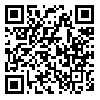Volume 28 - Supplementary
IBJ 2024, 28 - Supplementary: 28-28 |
Back to browse issues page
Download citation:
BibTeX | RIS | EndNote | Medlars | ProCite | Reference Manager | RefWorks
Send citation to:



BibTeX | RIS | EndNote | Medlars | ProCite | Reference Manager | RefWorks
Send citation to:
Fallahi S, Shojaee A, Zoghi G, Shahali Z, Ayoubian A, Mirhosseini S G. Evaluation of Clinical Manifestations Reported by the Public through Telephone Counseling of the Iran Health Insurance Organization in the Early Period of the COVID-19 Epidemic. IBJ 2024; 28 :28-28
URL: http://ibj.pasteur.ac.ir/article-1-4403-en.html
URL: http://ibj.pasteur.ac.ir/article-1-4403-en.html
Soghra Fallahi * 
 , Ali Shojaee
, Ali Shojaee 
 , Ghazal Zoghi
, Ghazal Zoghi 
 , Zahra Shahali
, Zahra Shahali 
 , Ali Ayoubian
, Ali Ayoubian 
 , Seyedeh Ghazal Mirhosseini
, Seyedeh Ghazal Mirhosseini 


 , Ali Shojaee
, Ali Shojaee 
 , Ghazal Zoghi
, Ghazal Zoghi 
 , Zahra Shahali
, Zahra Shahali 
 , Ali Ayoubian
, Ali Ayoubian 
 , Seyedeh Ghazal Mirhosseini
, Seyedeh Ghazal Mirhosseini 

Abstract:
Introduction: The coronavirus disease 2019 (COVID-19) as a global pandemic has become a burden on the healthcare system of many countries worldwide, including Iran, and caused more than a million deaths by the end of 2019. Therefore, this study aimed to identify the symptoms of COVID-19 in Iranian people to reduce the spread of the disease and manage it.
Methods and Materials: Using the census method, we conducted cross-sectional analyses of 12125 people calling for COVID-19 screening from 2 March 2020 to 19 April 2020. A telephone number was given to people for consulting with more than 70 nurses, and 30 medical doctors were responsible for considering the first- and second-level questions. Subsequently, a checklist of COVID-19-related symptoms was filled out for each participant. A chi-squared test and univariate logistic regression with SPSS 25 were used for statistical analysis.
Results: Of the 12125 participants in this study, 43.5% were male, and their mean age was 37.76 ± 16.61 years. The most common symptom was cough (41.3%), followed by shortness of breath (32.8%) and fever (31.5%), which was more prevalent among men. The least common complaint reported was confusion (1.6%). Our study revealed that men were at a higher risk of COVID-19 than women (OR: 1.31; 95% CI: 1.10-1.55; p = 0.002). Also, positive relationships were found between fever, chills, sore throat, shortness of breath, cough, body aches, and gastrointestinal symptoms with COVID-19.
Conclusion and Discussion: Our study revealed that cough, fever, and shortness of breath are the most common symptoms in people calling for COVID-19 consultation. It suggests that telehealth practices must be optimized more effectively in future crises.
Methods and Materials: Using the census method, we conducted cross-sectional analyses of 12125 people calling for COVID-19 screening from 2 March 2020 to 19 April 2020. A telephone number was given to people for consulting with more than 70 nurses, and 30 medical doctors were responsible for considering the first- and second-level questions. Subsequently, a checklist of COVID-19-related symptoms was filled out for each participant. A chi-squared test and univariate logistic regression with SPSS 25 were used for statistical analysis.
Results: Of the 12125 participants in this study, 43.5% were male, and their mean age was 37.76 ± 16.61 years. The most common symptom was cough (41.3%), followed by shortness of breath (32.8%) and fever (31.5%), which was more prevalent among men. The least common complaint reported was confusion (1.6%). Our study revealed that men were at a higher risk of COVID-19 than women (OR: 1.31; 95% CI: 1.10-1.55; p = 0.002). Also, positive relationships were found between fever, chills, sore throat, shortness of breath, cough, body aches, and gastrointestinal symptoms with COVID-19.
Conclusion and Discussion: Our study revealed that cough, fever, and shortness of breath are the most common symptoms in people calling for COVID-19 consultation. It suggests that telehealth practices must be optimized more effectively in future crises.

Type of Study: Full Length/Original Article |
Subject:
Cancer Biology
| Rights and permissions | |
 |
This work is licensed under a Creative Commons Attribution-NonCommercial 4.0 International License. |





.png)
